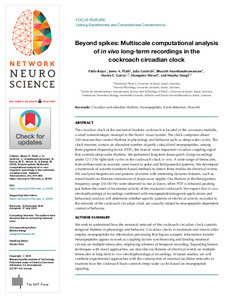View/
Date
2019-09-23Author
Rojas, PabloPlath, Jenny A.Gestrich, JuliaAnanthasubramaniam, BharathGarcia, Martin E.Herzel, HanspeterStengl, MonikaSubject
570 Life sciences; biologyMetadata
Show full item record
Aufsatz

Beyond spikes: Multiscale computational analysis of in vivo long-term recordings in the cockroach circadian clock
Abstract
The circadian clock of the nocturnal Madeira cockroach is located in the accessory medulla, a small nonretinotopic neuropil in the brain’s visual system. The clock comprises about 240 neurons that control rhythms in physiology and behavior such as sleep-wake cycles. The clock neurons contain an abundant number of partly colocalized neuropeptides, among them pigment-dispersing factor (PDF), the insects’ most important circadian coupling signal that controls sleep-wake rhythms. We performed long-term loose-patch clamp recordings under 12:12-hr light-dark cycles in the cockroach clock in vivo. A wide range of timescales, from milliseconds to seconds, were found in spike and field potential patterns. We developed a framework of wavelet transform–based methods to detect these multiscale electrical events. We analyzed frequencies and patterns of events with interesting dynamic features, such as mixed-mode oscillations reminiscent of sharp-wave ripples. Oscillations in the beta/gamma frequency range (20–40 Hz) were observed to rise at dawn, when PDF is released, peaking just before the onset of locomotor activity of the nocturnal cockroach. We expect that in vivo electrophysiological recordings combined with neuropeptide/antagonist applications and behavioral analysis will determine whether specific patterns of electrical activity recorded in the network of the cockroach circadian clock are causally related to neuropeptide-dependent control of behavior.
Citation
In: Network Neuroscience Volume 3 / Issue 4 (2019-09-23) , S. 944-968 ; ISSN 2472-1751Sponsorship
Gefördert durch den Publikationsfonds der Universität KasselCitation
@article{doi:10.17170/kobra-20191122807,
author={Rojas, Pablo and Plath, Jenny A. and Gestrich, Julia and Ananthasubramaniam, Bharath and Garcia, Martin E. and Herzel, Hanspeter and Stengl, Monika},
title={Beyond spikes: Multiscale computational analysis of in vivo long-term recordings in the cockroach circadian clock},
journal={Network Neuroscience},
year={2019}
}
0500 Oax 0501 Text $btxt$2rdacontent 0502 Computermedien $bc$2rdacarrier 1100 2019$n2019 1500 1/eng 2050 ##0##http://hdl.handle.net/123456789/11365 3000 Rojas, Pablo 3010 Plath, Jenny A. 3010 Gestrich, Julia 3010 Ananthasubramaniam, Bharath 3010 Garcia, Martin E. 3010 Herzel, Hanspeter 3010 Stengl, Monika 4000 Beyond spikes: Multiscale computational analysis of in vivo long-term recordings in the cockroach circadian clock / Rojas, Pablo 4030 4060 Online-Ressource 4085 ##0##=u http://nbn-resolving.de/http://hdl.handle.net/123456789/11365=x R 4204 \$dAufsatz 4170 7136 ##0##http://hdl.handle.net/123456789/11365
<resource xsi:schemaLocation="http://datacite.org/schema/kernel-2.2 http://schema.datacite.org/meta/kernel-2.2/metadata.xsd"> 2019-11-22T15:09:44Z 2019-11-22T15:09:44Z 2019-09-23 doi:10.17170/kobra-20191122807 http://hdl.handle.net/123456789/11365 Gefördert durch den Publikationsfonds der Universität Kassel eng Urheberrechtlich geschützt https://rightsstatements.org/page/InC/1.0/ circadian and ultradian rhythms neuropeptides event detection wavelet 570 Beyond spikes: Multiscale computational analysis of in vivo long-term recordings in the cockroach circadian clock Aufsatz The circadian clock of the nocturnal Madeira cockroach is located in the accessory medulla, a small nonretinotopic neuropil in the brain’s visual system. The clock comprises about 240 neurons that control rhythms in physiology and behavior such as sleep-wake cycles. The clock neurons contain an abundant number of partly colocalized neuropeptides, among them pigment-dispersing factor (PDF), the insects’ most important circadian coupling signal that controls sleep-wake rhythms. We performed long-term loose-patch clamp recordings under 12:12-hr light-dark cycles in the cockroach clock in vivo. A wide range of timescales, from milliseconds to seconds, were found in spike and field potential patterns. We developed a framework of wavelet transform–based methods to detect these multiscale electrical events. We analyzed frequencies and patterns of events with interesting dynamic features, such as mixed-mode oscillations reminiscent of sharp-wave ripples. Oscillations in the beta/gamma frequency range (20–40 Hz) were observed to rise at dawn, when PDF is released, peaking just before the onset of locomotor activity of the nocturnal cockroach. We expect that in vivo electrophysiological recordings combined with neuropeptide/antagonist applications and behavioral analysis will determine whether specific patterns of electrical activity recorded in the network of the cockroach circadian clock are causally related to neuropeptide-dependent control of behavior. open access Rojas, Pablo Plath, Jenny A. Gestrich, Julia Ananthasubramaniam, Bharath Garcia, Martin E. Herzel, Hanspeter Stengl, Monika doi:10.1162/netn_a_00106 publishedVersion ISSN 2472-1751 Issue 4 Network Neuroscience 944-968 Volume 3 </resource>
The following license files are associated with this item:
Urheberrechtlich geschützt

